Social Science
Research Round-Up

Staff in the Social Sciences Division conduct professional research as a way to contribute to the library profession and as a way to engage with library peers beyond Berkeley. Here is a round-up of some recent research output (articles, presentations, etc.) by our colleagues in the division.
Church, James and Josh Quan. 2018. “Patron Driven Data Acquisitions: Prizes, Perils, and Pitfalls.” Federal Reserve Bank of St. Louis. This presentation at the Federal Reserve Bank of St. Louis conference, “Beyond the Numbers: The Economic Data Ecosystem,” chronicles the successes, failures, and lessons learned from a patron driven data acquisitions program piloted by UC Berkeley Library.
Church, James, Susan Paterson, Amanda Wakaruk, and James R. Jacobs. 2018. “Endangered Government Information: Strategies to Protect Government Collections.” New Orleans, LA: American Library Association. This presentation at the American Library Association Annual Conference in New Orleans discussed methods and strategies on how to protect endangered government information in Canada and the United States.
Edwards, Susan, Chan Li, Celia Emmelhainz, Adam Clemons, Liladhar Pendse, and Natalia Estrada. 2018. “Collecting Globally, Connecting Locally: 21st Century Libraries.” P. 700 in Library Assessment Conference: Building Effective, Sustainable, Practical Assessment. Houston, TX. Presented at the ARL Library Assessment Conference, Houston, this research project used mixed methods to explore faculty beliefs about, and scholarly usage of, non-U.S./U.K. and non English language sources focusing on four departments with global research focus — Anthropology, History, Political Science and Sociology.
Emmelhainz, Celia and Marilyn R. Pukkila. 2018. “Being There at a Distance: Connecting the Academic Library to Students Who Study Abroad.” College & Research Libraries News 79(7):376. After meeting with study abroad students in orientation then surveying them after their programs, librarians found that while outreach results in limited additional usage of library resources, it significantly increases student awareness of library resources and feelings of being supported while conducting research on the other side of the world.
Glusker, Ann. 2019. “Collaboration and Innovation: NNLM’s Nationwide Online Wikipedia Edit-a-Thon.” This talk at the Online Northwest conference on libraries, technology, and culture, reports on the National Network of Libraries of Medicine’s (NNLM) ongoing Wikipedia edit-a-thon program, how the the unusual format worked, and tips for hosting an online edit-a-thon.
Glusker, Ann and Nina Exner. 2018. “Responding to Change: Reinventing Librarian Identities in the Age of Research Mandates.” Emerald Publishing Limited. This chapter outlines libraries’ (and librarians’) changing identities in the new world of research mandates from funders, institutions, and publishers.
Phillips, Margaret. 2019. “Readers and Authors of Educational Research: A Study of Research Output on K-12 Education Policy.” SAGE Open 9(2). Focusing on journal articles and reports in the field of education, this study examined the public availability of the publications, publication quality as determined by peer review, and authorship.
Schiraldi, Hilary. 2019. “Stepping Up Library Communications at UC Berkeley.” This poster, presented at the Academic Business Library Director’s Annual Meeting, describes the new Communications Department in the UC Berkeley Library and how it pulled together multiple library communications channels under one unit.
Singh, Monica and Celia Emmelhainz. 2019. “Listening to Unaffiliated Users of the Academic Library.” SAGE Open 9(2). In this study the authors interviewed 10 unaffiliated library users to better understand their perceptions of a large academic library and how the library fits into their daily habits.
An Assembly of Janeites
I’m not sure what the collective noun is for Janeites* (the term popularized by Rudyard Kipling in his short story by that name) to denote admirers of the Georgian-era British novelist Jane Austen, but assembly will do as well as anything! The recent Annual General Meeting (AGM) of the Jane Austen Society of North America (JASNA), held in Williamsburg, VA was indeed an assembly of Janeites, and a fascinating one, attended by this UC Berkeley librarian (incidentally, a JASNA life member from long before the Colin Firth wet shirt scene).
JASNA has upwards of 6,000 members worldwide, and an impressive 850 attended this AGM (which filled up within five minutes of going live online), from every US state but 3 and every continent but Antarctica. The AGM is an agreeable panoply of lectures (some popular, but mostly academic, including three excellent plenary addresses), special events such as tours and concerts, and a ball and promenade. To say it’s a cross between a ComicCon-like event and a discipline-specific scholarly gathering doesn’t do it justice—there is some indefinable aspect added by the focus on the Georgian/Regency era and the passion for one ironic, wise, delectable, insightful, and compassionate author. And the period-appropriate garb doesn’t hurt, especially when its background is Colonial Williamsburg, a veritable time capsule itself.
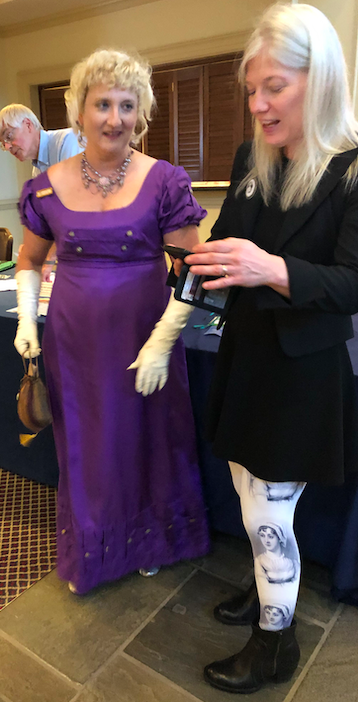
Herewith some highlights of this year’s AGM, for you readers who are interested in a glimpse of this delightful conclave:
—Let’s begin with some academic cred! Here are the lists of the conference’s breakout sessions and plenary addresses, complete with presenters’ bios. Nothing if not majestic scholarship on show!
—Continuing with the academic theme, my favorite part of the entire conference (what can I say? I’m a librarian!) was the tour and open house of Special Collections at the library of the College of William & Mary. William & Mary is second only to Harvard University as the oldest higher education institution in the US, was founded in 1693, and is the only one founded by royal charter, from, you guessed it, co-regnants William and Mary. For more detail on the tour, see this piece which appeared in William & Mary news. Overall, it was just amazing to see the depth of the holdings, and those related to Jane Austen in particular. Some of the most notable are thanks to an American Janeite, George Holbert Tucker, whose extensive and meticulously documented collection is now held at William & Mary. At the same time, there were many other period treasures on display, among them this donation of a lock of Queen Mary’s hair.
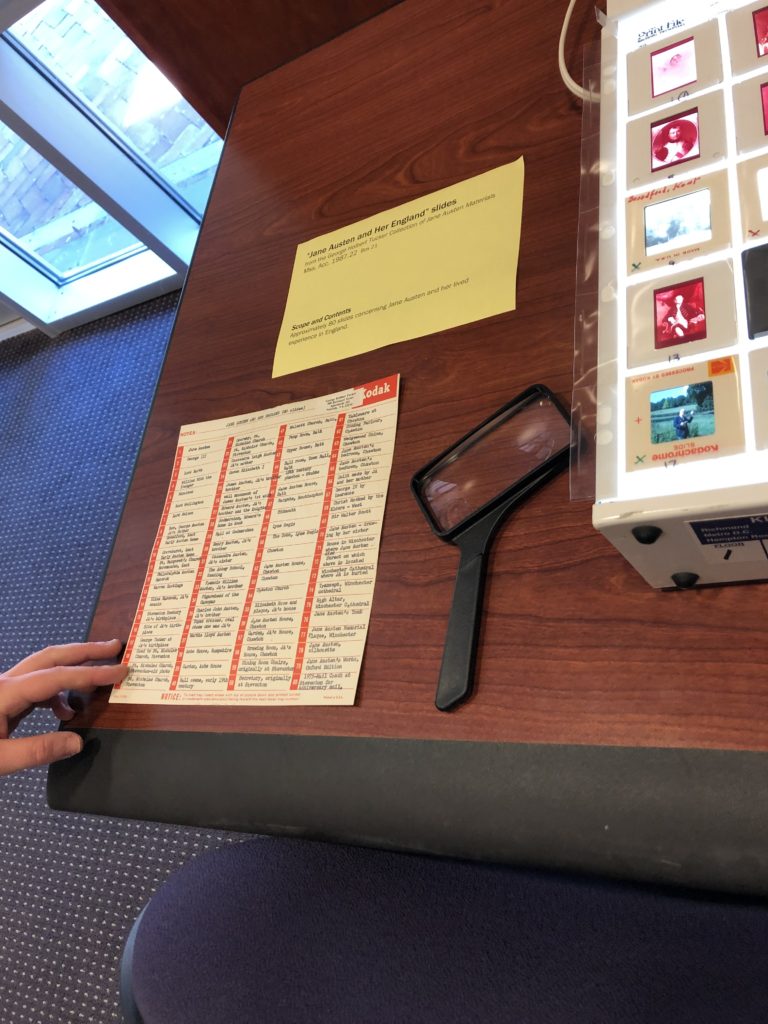
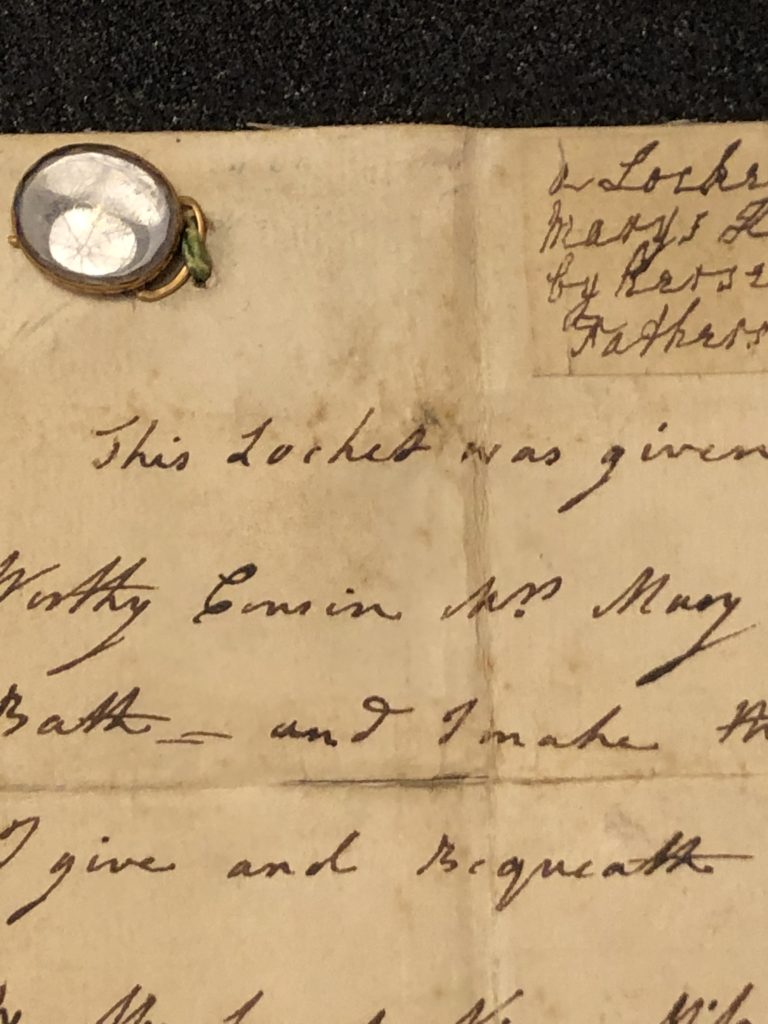
—Of course, there were also tours of Colonial Williamsburg. Of special interest was the home of George Wythe (the original structure still stands), with whom Thomas Jefferson lived and studied law for three years. John Marshall, fourth Chief Justice of the Supreme Court, also lived in Williamsburg and studied with Wythe; in addition, Marshall liked reading Jane Austen! He wrote of her: “Her flights are not lofty, she does not soar on an eagle’s wings, but she is pleasing, interesting, equable, yet amusing.”
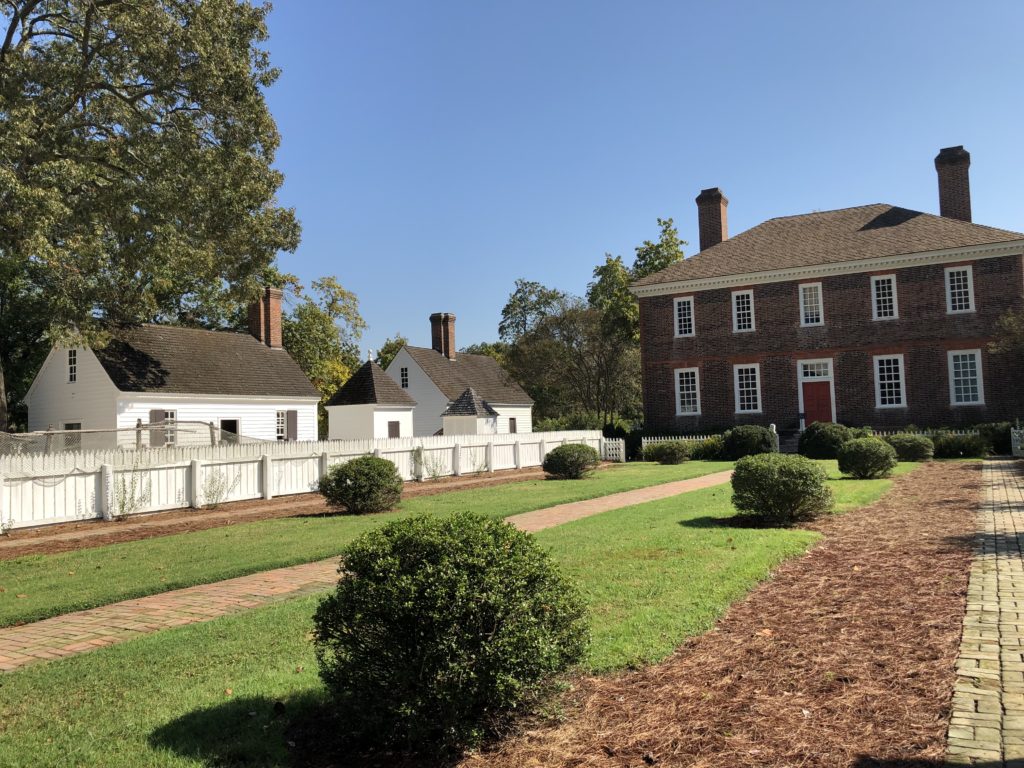
Also, being a librarian, I was very interested to see a demonstration of colonial-era typesetting and printing (unfortunately, the bookbinding demonstrations were not happening when I was there):
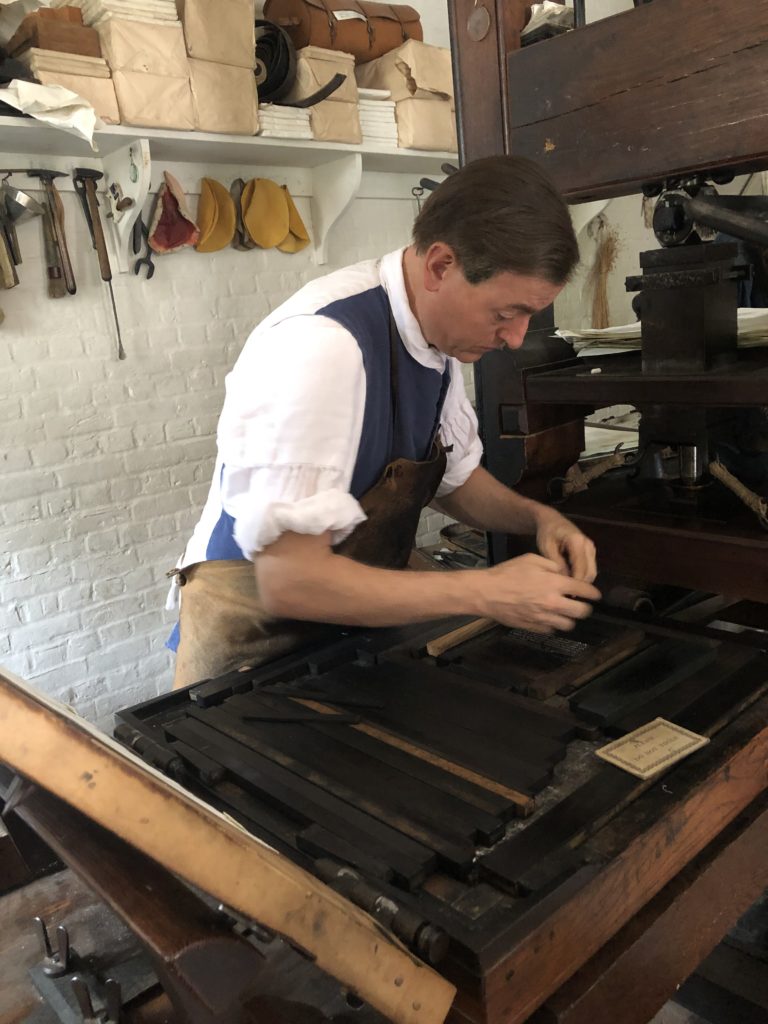
—The promenade and ball are the hallmarks of any AGM. After dinner, the entire assembly does a promenade, in their finery for the ball, around any location at which they happen to be meeting (when I attended an AGM in Washington DC, the promenade took place on the escalators connecting four levels of the hotel— quite a sight). This time, we strolled at dusk to the Governor’s Palace, led by four torch bearers (with modern protective gear—those torches were huge!) where an actress told us period-appropriate ghost stories. Then we gathered for the ball, to dance and drink and carouse. The music was provided by a small string ensemble, and a caller with the calmest voice imaginable led the lines of dancers in the sometimes-intricate moves. Luckily everyone was good-humored!

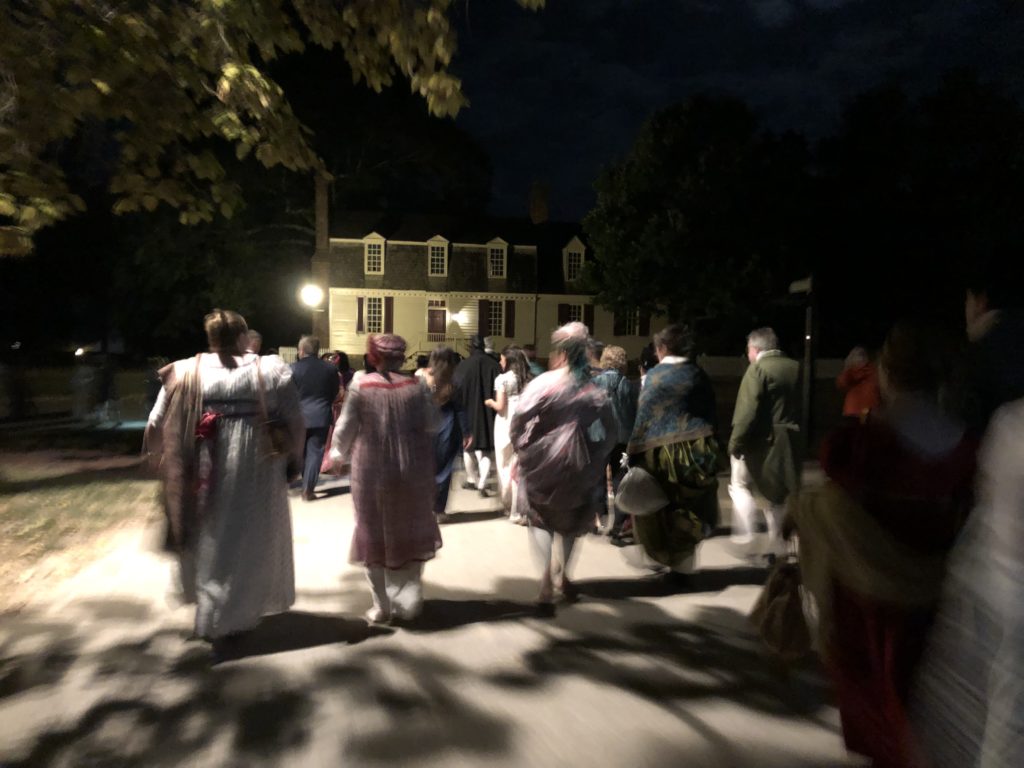
—The attention to dress is something that has always marked an assembly of Janeites (as it marked the interests of many of Jane Austen’s characters, at a time when distinctions in dress spoke more loudly than words). At the conference, this could be seen in both modern expressions (as in this T-shirt with its reference to Lady Catherine de Bourgh’s admonishment of Elizabeth Bennet in Austen’s Pride and Prejudice), and in scrupulous care with period detail in the many outfits worn by attendees, especially at the ball. In Colonial Williamsburg, where the park interpreters are dressed in colonial era period-appropriate apparel (mostly from the second half of the 18th century), conference attendees in Georgian/Regency attire (from the late 18th to early 19th centuries) didn’t stand out as much to our modern eyes. However, they would have stood out in the late 1700s, when wearing rich and patterned clothing identified one as a loyalist to the crown, and was positively unpatriotic (patriots wore homespun).
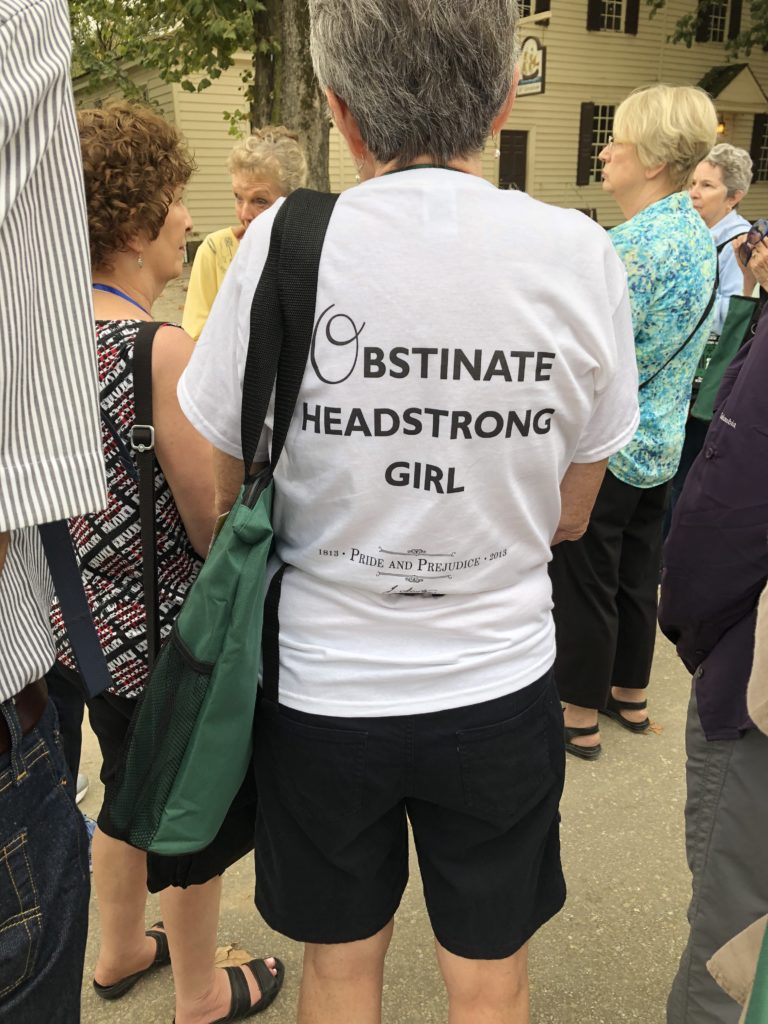
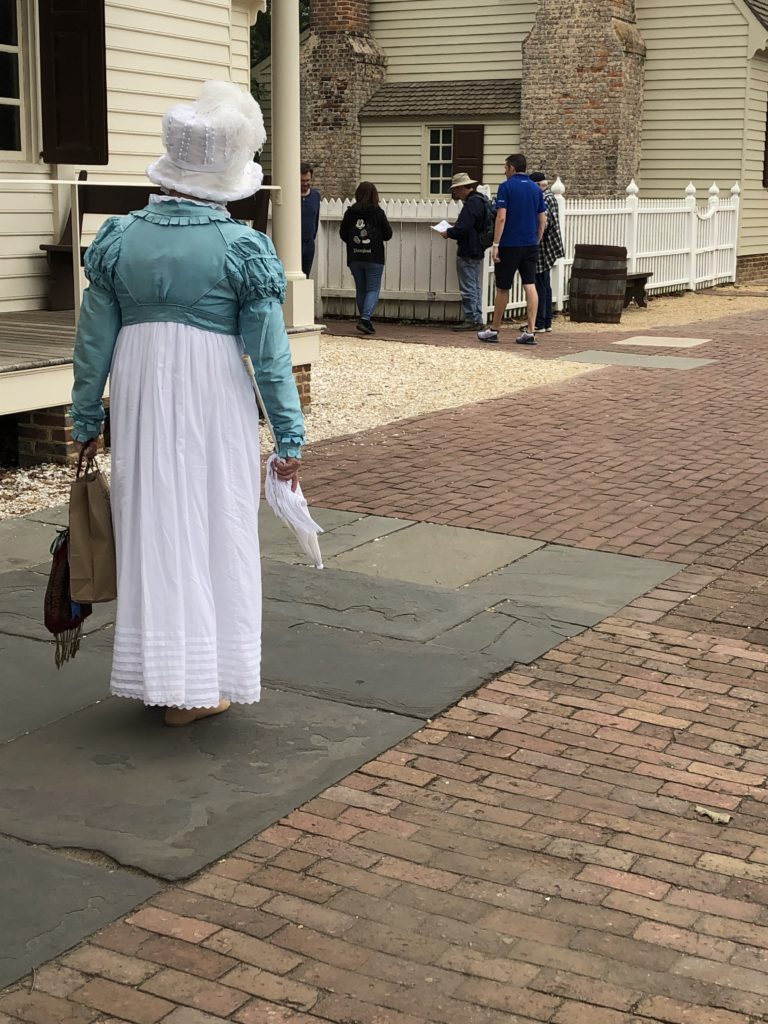
—On the final afternoon, there was an 18th century cricket demonstration. The rules were somewhat different then than in modern cricket! (the largely north American audience might not have been as aware of differences). And in case you are wondering that the photo shows a woman playing, Austen tells us that Catherine Morland, heroine of Northanger Abbey (the novel on which this year’s conference focused) loved cricket as a girl and played it with her brothers!
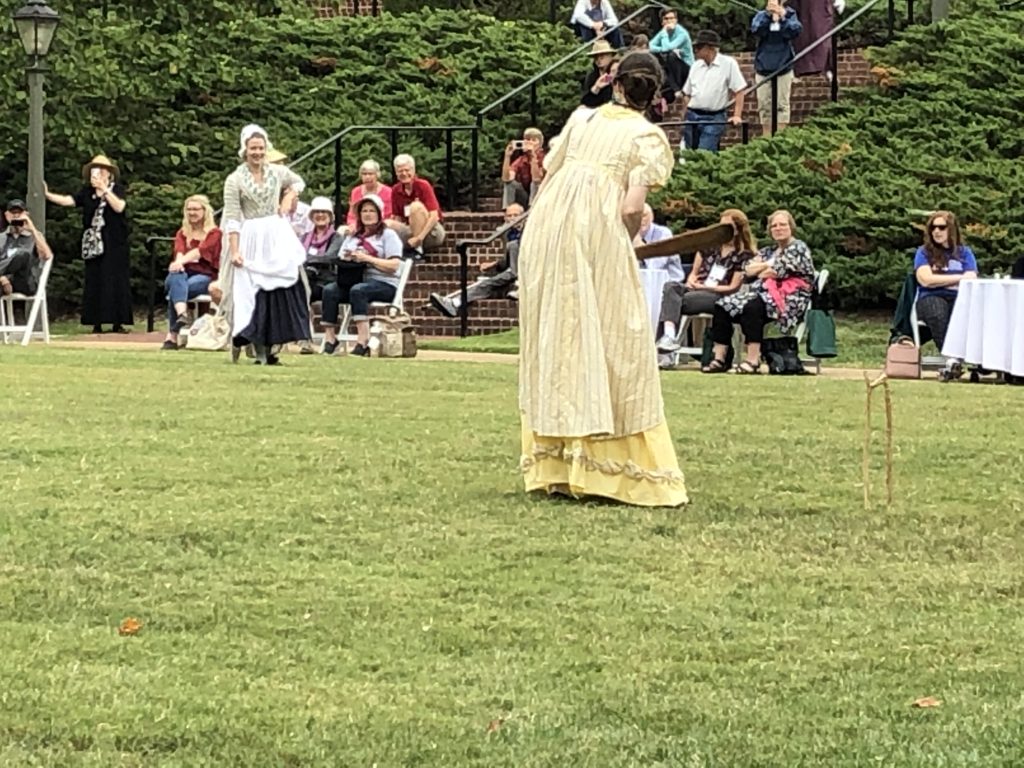
Intrigued? If you haven’t read any Jane Austen, or if you tried as a teenager and couldn’t warm to it, maybe have another look… Here is a complete set, free and online, from the wonderful Project Gutenberg. For introductions to her life and work, try Jane Austen (with an introduction by Harold Bloom), or The Cambridge Introduction to Jane Austen. And for more reading on Jane Austen devotees, try Among the Janeites or The Making of Jane Austen. For a video of a spirited debate comparing Jane Austen and Emily Brontë, check out this one from IntelligenceSquared. And consider joining us at the JASNA 2020 AGM next year in Cleveland!
*The term Janeite is often not used as a compliment; see this decidedly non-neutral Wikipedia overview. However, for the purposes of this article, the term is used affectionately!
New Display Case in Environmental Design Library
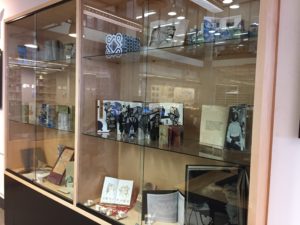
With the help of Semar Prom and the College of Environmental Design Fabrication Shop staff, the Environmental Design Library has installed a new display case. The new case will allow for informal display of artists’ books, the library’s rare books, and timely topical information relevant to the college. Currently on display are items from the upcoming 10/25/19 Hands On Artists’ Book event featuring newly acquired artists’ books.
Hands On 18: Recent Acquisitions – 10/25/19
Artists’ books are simply books made by artists. Whether tactile or conceptual, they range in thematic content including the political, the sentimental, the instructive, or the purely beautiful. Our next event will feature recent acquisitions for you to touch, turn pages, and experience. Friday, October 25, 2019 – 4-6pm, 210 Wurster Hall – Environmental Design Library.
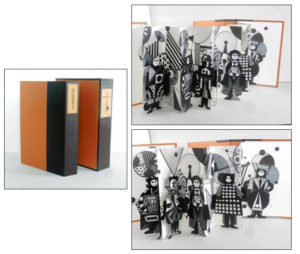
Hands On Artists’ Books: Water, Water Everywhere – 9/13 from 4-6 210 Wurster Hall
Artists’ books are simply books made by artists. Whether tactile or conceptual, they range in thematic content including the political, the sentimental, the instructive, or the purely beautiful. Our Hands On Artists’ Book events allow you to handle books from our rare book vault. For our first event of the academic year, we will have 20 books related to water, its presence and importance, for you to touch, turn pages, and experience. Wine and light refreshments will be served in the Environmental Design Library Atrium. hands on 17
The Versatility Chronicles: Hilary Schiraldi, Berkeley Librarian and Powerlifter
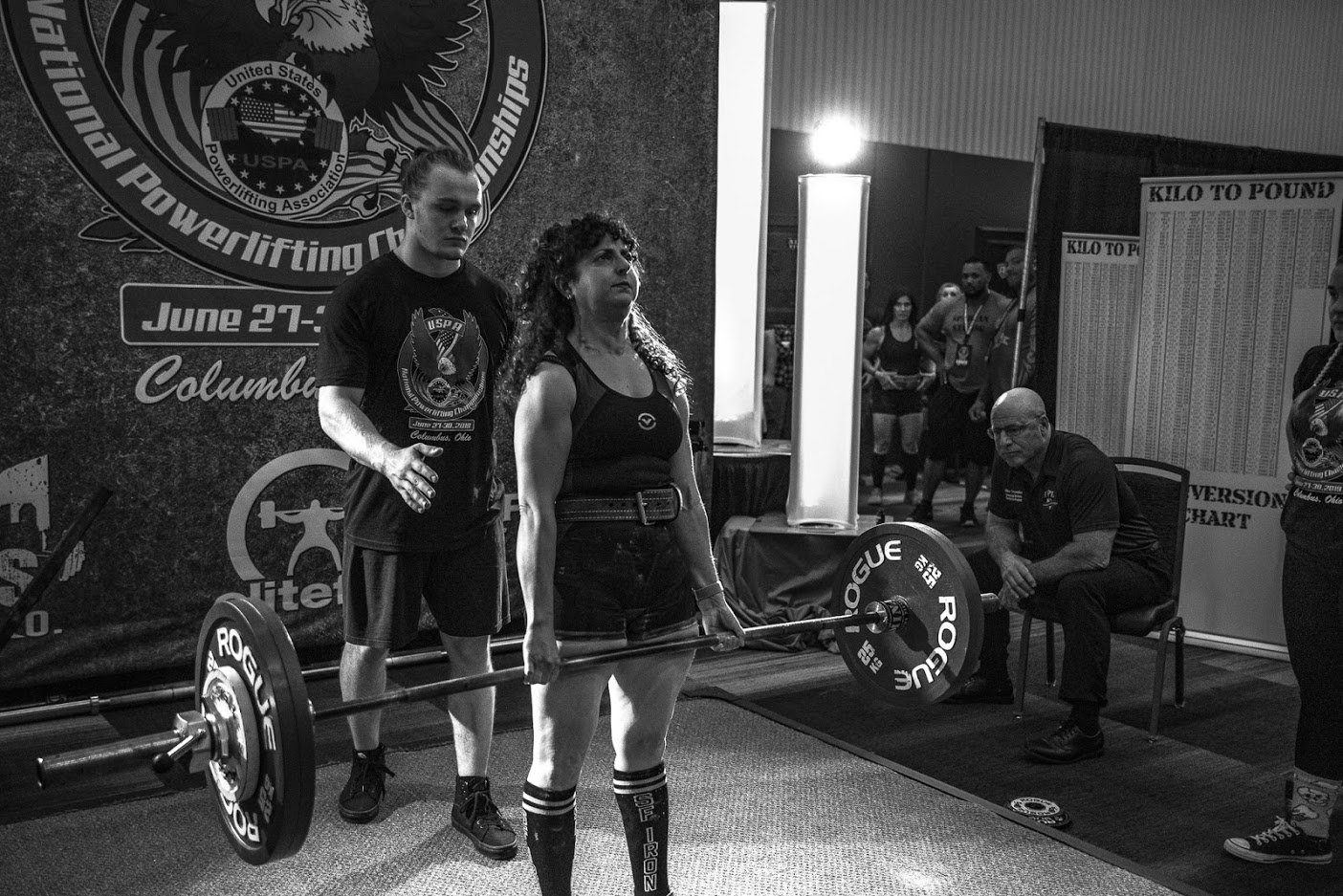
Library staff are just about the most intellectually curious people there are, and with social sciences being such an interdisciplinary scholarly endeavor, you’d expect people from our division to have diverse interests outside of the workplace as well as in. Watch this space– we’ll occasionally be highlighting some of the non-workplace pursuits of our versatile workforce, starting with the amazing Hilary Schiraldi. In addition to being a Business Librarian in the Social Sciences Division, she is a nationally ranked powerlifter in her age/weight class.
Hilary came to powerlifting (not the same as the weightlifting events we see in the Olympics, or Strongman, or bodybuilding, or even Highland Games) early. She realized in high school that she enjoyed working with weights, and at Berkeley she actually started teaching herself basic powerlifting by taking a class with Cal’s Rec Sports, joining the Rec Sports Facility, and (natch, she’s a librarian!) reading a book. But her practice changed direction when she had a little time to kill in the neighborhood South of Market in SF, and she found a barbell gym, SF Iron, and her new coach, Scott Kaplan.
With coaching, she really took off, and after doing several local competitions, eventually qualified to go to the USPA National Powerlifting, Benchpress and Deadlift Championships in Columbus, OH at the end of June. In the event, Hilary participated in three different types of lifts: the bench press and deadlift as you’d expect from the event title, and also the squat (here’s a good overview of what’s involved in these lifts). In each case, she lifted different sets of weights with different techniques (and luckily using different sets of muscles too, since all of her lifts happened on the same day). She had three attempts to lift (and increase the weight at each attempt) for each event. In the end, she was pleased with how she did, achieving her first attempt at the benchpress (darn it, her rear end lifted from the bench on the second attempt), her second attempt at the squat, and all the way to her third attempt at the deadlift, lifting 137.5 kg/303 lbs., a personal best. This meant she was third nationally in her age/weight class, earning a spot on the podium!
Like any world where people pursue a passion, powerlifting has communities and a culture of its own, and it’s one in which Hilary thrives (although she did enter another world in Columbus, making scented candles the day before she competed). It’s fascinating to listen to her talk about her experiences, and if you want to hear and see more, check out her Instagram account at hil_schi (also if you really want to follow in her footsteps, her coach is @the_kaplan_method and her gym is @sf_iron). And maybe consider learning to lift yourself? It’s great for your bones and musculature, especially your stabilizing muscles. Competing in all three events Hilary did is called full power, and who doesn’t want that? Here’s to versatility, and work-life balance, and Hilary’s FULL POWER!
Social Science Staff Selections for Summer–Sweet!
Summer is for relaxation and reading–and, if you are an incoming Berkeley student, there is a wonderful summer reading list, complete with links to previous lists (going back 30 years!) It made us in the Social Sciences Division wonder, what are our colleagues reading this summer? The answers are quite wonderful….
DAVID E:
Short reads guaranteed to wake you up if you’re not already woke.
A Billion Black Anthropocenes or None – Kathryn Yusoff – a concise, theoretical volume at the intersection of Black feminist theory and earth sciences that makes the point that geology, as currently defined in discussions of the Anthropocene, is a White construction that erases black and brown slavery, exploitation and objectification that created conditions now being referred to as the “anthropocene.”
Extinction: A Radical History – Ashley Dawson – a materialist analysis of of extinction theory that places capitalism at the heart of environmental degradation and the attack on the global commons. A response to those who, in the words of Andrew Ross, “have drunk the Kool-Aid of green capitalism.”
On Tyranny: Twenty Lessons from the Twentieth Century – Timothy Snyder – A Yale historian synthesizes lessons learned by deep exploration of capitalist and communist dictatorships into this very concise volume of “lessons” in preparation for the atacks against democracy heralded by the arrival of Trump to office.
Zen in the Art of Permaculture Design – Stefan Geyer – brief Zen meditations and thoughts related to the practice of permaculture — design agricultural thinking in the service of the planet and humanity.
ANN G:
Can’t We Talk About Something More Pleasant? – Roz Chast
It’s always amazing to me how New Yorker cartoonist Roz Chast gets to the heart of an issue with her dark, dry and hysterically funny perspective. In this graphic memoir she treats us to her wry, poignant, and totally on-the-mark observations about the aging of her parents. While this book can sometimes be tough to read, it also is endlessly thought-provoking and an unforgettable laugh-out-loud page-turner.
SUSAN E:
To the End of the Land – David Grossman
A brilliant, immersive journey with an Israeli mother hiking cross-country with one heartfelt goal– to not be home when the “notifiers” come to deliver the news of her beloved son, serving in the Israeli Army. As Colm Toibin’s review in the NYTimes states, “To say this is an antiwar book is to put it too mildly, and in any case such labels do an injustice to its great sweep, the levels of its sympathy.” It’s an incredibly moving exploration of the depth of parental love and the true cost of war.
BRIAN L:
Trail of Lightning – Rebecca Roanhorse
Here’s a great fiction suggestion, which I read last year. The author is an up and coming super star, she is Native American, and her post-apocalyptic fiction takes place with an all Native American cast, which gives a bit of a different flair to your standard post-apocalyptic piece. It’s a page turner!! Her sequel, Swarm of Locusts, was published a few weeks ago and I already devoured it.
CELIA E:
Pressure Cooker: Why Home Cooking Won’t Solve Our Problems and What We Can Do About It– Sarah Bowen, Joslyn Brenton, and Sinikka Elliott
Social scientists wanted to understand what it takes for working families to get food on the table—but 150 interviews weren’t enough. So they followed 12 North Carolina families around as they fought, played, shopped, and barbecued together. The result is a lively picture of what it takes to get food on the table while working, among all the pressures on women to cook “right” for their families. Stories from nine families are woven together in a critique of the easy advice we all get: shop smarter, make time, know what’s on your plate. This very readable book concludes with practical tips to make home cooking work better in your real American life.
MARGARET P.
Coming-of-age memoirs by stand-up comedians are a guilty pleasure. Bonus points if the words “gritty,” “harrowing” or “deeply affecting” can be used to describe them. Among the recent standouts in this genre: The Last Black Unicorn in which Tiffany Haddish covers everything from mental illness (her mother’s) and foster care to intimate partner violence and homelessness. Yes, this memoir is classified under “humor.” In Born a Crime: Stories from a South African Childhood, Daily Show host Trevor Noah describes growing up mixed race in the township of Soweto during the early post-apartheid era. The real hero of the story? Noah’s remarkable and willful mother Patricia. How to American: An Immigrant’s Guide to Disappointing Your Parents by Jimmy O. Yang. What immigrant story doesn’t involve learning English by watching BET RapCity, DJing at a strip club and driving Uber before hitting it big in Hollywood? (Okay, this memoir is not exactly harrowing but it’s definitely laugh-out-loud funny.)
MOLLY R.
In the Distance – Hernan Diaz
This is the story of a Swedish immigrant wandering through the 19th century American West, trying to reach New York from California in search of his brother. He doesn’t know the language to easily communicate with those he meets along the way nor does he know what to expect as he travels across the country. The book fully portrays this isolation and the descriptions of the landscape are beautifully written. Nominated for Pulitzer Prize in 2018
MONICA S:
Destiny Disrupted: A History of the World Through Islamic Eyes by Tamim Ansary is a fascinating sweep of the rise and heyday of Islam-based empires and cultures. The title says it all, I cannot add more to that description.
For summer armchair travel through a land and culture that was, not so very long ago, full of great hope and promise, check out Eric Newby’s delightful A Short Walk in the Hindu Kush.
NATALIA E.
The Terror – Dan Simmons
In 1845, Captain Sir John Franklin led an expedition to find the North-West Passage. With 134 men aboard the HMS Erebus and the HMS Terror, he set sail for the Arctic. No one heard from them again. This historical fiction focuses on what could have happened to the crew as they faced the environment, starvation, and an unknown creature hunting them down. It’s horror exploring the consequences of hubris, class tensions, and just general bad ideas. It’s also the basis of a great mini-series, also called The Terror, that came out last year.
The Dark Forest – Cixin Liu, translated by Joel Martinsen
I will not stop until more people read the Remembrance of Earth trilogy. But if you can only pick one 500+ page entry, make it The Dark Forest. The follow-up to The Three Body Problem, Earth faces an upcoming alien invasion that plans to wipe out humanity. How can the planet protect itself when the the aliens can monitor all information exchanged? And why does the best hope for survival lie in a … cosmic anthropologist? Read not just for the sci-fi action, which there is plenty, but for deep conversations on who has the right to be saved, who can be trusted, and why you probably shouldn’t get up close to shiny metal space objects.
Her Body and Other Parties: Stories – Carmen Maria Machado
Sure, I can talk about the retelling of the story of the girl with green ribbon, told from the perspective of the girl. Or the story of the woman who takes extremes to lose weight. But let me ask you this: have you not wanted capsule summaries of 272 episodes of Law and Order: SVU? Will the unit solve this murder? Will Benson and Stabler act on all that sexual tension? Why are all these ghost girls with bells for eyes hanging out in Benson’s apartment?? It’s called “Especially Heinous: 272 Views of Law & Order SVU”, and it’s in Her Body and Other Parties. You should read it.
Library Prize Exhibit: Sympathy for the Loss of a Comrade
By Adam Clemons
In early July of 1873, a soldier named John Taylor reported to the hospital at Fort Stockton, Texas complaining of illness. The fort’s doctor, Peter J.A. Cleary, refused to treat him. Instead, he sent Taylor to the guard house as punishment. Three days later John Taylor was dead. Taylor’s fellow soldiers, incensed by what they believed to be racially motivated medical neglect by Cleary, drafted a statement detailing the patterns of abusive treatment of Taylor and calling for a formal investigation into his death. The officers at Fort Stockton responded by placing twenty-one of the soldiers who signed the letter, mostly non-commissioned officers, on trial for attempted mutiny. Though the charge was ultimately downgraded to a failure to follow proper procedure, twenty out of the twenty-one charged soldiers were dishonorably discharged and sent to prison in Huntsville, Texas.



Photos by Jami Smith for the UC Berkeley Library
In “Sympathy for the Loss of a Comrade: Black Citizenship and the 1873 Fort Stockton ‘Mutiny’,” Nick Eskow successfully reconstructed the events at Fort Stockton using library resources such as period publications, government documents, newspapers, and archival collections. Where others have relied on the accounts of the white officers to tell this story, Eskow sought out the perspective of the black soldiers through extensive research and analysis of the historical record. Eskow’s exceptional effort earned him the prestigious 2018 Charlene Conrad Liebau Library Prize for Undergraduate Research, an annual prize awarded to students who have done high-level, course-based research while demonstrating significant use of the Library’s resources.
Eskow’s research is also the subject of the rotating Library Prize Exhibit, located on the second floor of Doe Library between Heyns Reading Room and Reference Hall. Drawing on collections held at UC Berkeley, Fort Stockton, Texas, and the National Archives in Washington, D.C., the exhibit displays some of the documents Eskow used to capture the voice of the black soldiers including a digital version of the original petition letter, which includes a few pages of soldiers’ signatures to show the “X” marks by many names. These marks, meant to stand for “his mark,” indicates that many of the soldiers, who were former slaves, could not sign their names and implies that they could neither read nor write. Other documents on display include an 1868 copy of S.V. Benet’s A Treatise on Military Law and Practice of Courts-Martial, which was repeatedly cited by the white officers at Fort Stockton to support their charge against the black soldiers as well as a detailed timeline of the events at Fort Stockton from the death of John Taylor to the sentencing of the twenty soldiers who signed the petition letter.
The Charlene Conrad Liebau Library Prize for Undergraduate Research is awarded annually to UC Berkeley undergraduates. Any course-based research projects completed at UC Berkeley during the award year are eligible. In addition to a monetary prize for winners – $750 for lower division and $1000 for upper division – award recipients as well as honorable mentions will publish their research in eScholarship, the University of California’s open access publishing platform. Two of the winners are also be featured in an exhibit in the Library.
The exhibit – which was curated by Adam Clemons, Librarian for African and African American Studies, and designed by Aisha Hamilton, Exhibits and Environmental Graphics Coordinator – will be up until November 2019.
Berkeley Research Impact Initiative and the Social Sciences
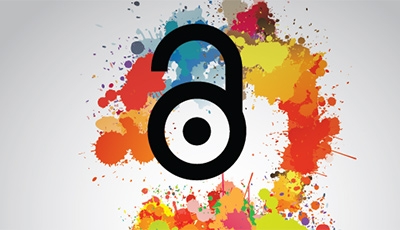 The Berkeley Research Impact Initiative (BRII) aims to foster broad public access to the work of Berkeley scholars by encouraging the Berkeley community to take advantage of open access (OA) publishing opportunities. To accomplish this, it provides funding to Berkeley authors to make their publications free to all readers immediately upon publication.
The Berkeley Research Impact Initiative (BRII) aims to foster broad public access to the work of Berkeley scholars by encouraging the Berkeley community to take advantage of open access (OA) publishing opportunities. To accomplish this, it provides funding to Berkeley authors to make their publications free to all readers immediately upon publication.
Making scholarly work available open access means that there is barrier-free access to research output and that it is not locked behind a paywall. This means there is potential for wider readership and greater impact. However, as publishers have increasingly been charging authors sometimes substantial amounts for “unlocking” their work and making it OA, many authors need financial assistance. With Berkeley’s commitment to making its scholarly outputs OA, the BRII program is the natural response to this situation.
Berkeley authors who have had an article accepted by an open access journal that charges authors an Article Processing Charge (APC) may apply to BRII for reimbursement. Similarly, authors of scholarly books may apply to BRII to for a book subvention. While many of the authors funded are in life and medical sciences or natural resources, a growing number of Berkeley authors in the social sciences have published open access using BRII funding.
If you have questions about the BRII program or open access, talk to your subject librarian.
Below is a very brief list of a few recent BRII-funded articles in the social sciences, listed by the department affiliation of the Berkeley author. Thanks to the assistance of BRII, these articles are free and openly available for any and all users.
Anthropology
Yurchak, Alexei. 2017. “The Canon and the Mushroom: Lenin, Sacredness, and Soviet Collapse.” HAU: Journal of Ethnographic Theory 7 (2): 165–98. https://doi.org/10.14318/hau7.2.021.
Archaeological Research Facility
Lightfoot, Kent G., and Sara L. Gonzalez. 2018. Metini Village: An Archaeological Study of Sustained Colonialism in Northern California.
Institute of Governmental Studies
Geography
Jadhav, Adam, Sharolyn Anderson, Michael J. B. Dyer, and Paul C. Sutton. 2017. “Revisiting Ecosystem Services: Assessment and Valuation as Starting Points for Environmental Politics.” Sustainability 9 (10): 1755. https://doi.org/10.3390/su9101755.
Haas School of Business
Wagner, Zachary, John Bosco Asiimwe, William H. Dow, and David I. Levine. 2019. “The Role of Price and Convenience in Use of Oral Rehydration Salts to Treat Child Diarrhea: A Cluster Randomized Trial in Uganda.” PLOS Medicine 16 (1): e1002734. https://doi.org/10.1371/journal.pmed.1002734.
Linguistics
Bakst, Sarah, and Keith Johnson. 2018. “Modeling the Effect of Palate Shape on the Articulatory-Acoustics Mapping.” The Journal of the Acoustical Society of America 144 (1): EL71–75. https://doi.org/10.1121/1.5048043.
Psychology
Diamond, Allison E., and Aaron J. Fisher. 2017. “Comparative Autonomic Responses to Diagnostic Interviewing between Individuals with GAD, MDD, SAD and Healthy Controls.” Frontiers in Human Neuroscience 10. https://doi.org/10.3389/fnhum.2016.00677.
Marcelle, Enitan T., Laura Nolting, Stephen P. Hinshaw, and Adrian Aguilera. 2019. “Effectiveness of a Multimodal Digital Psychotherapy Platform for Adult Depression: A Naturalistic Feasibility Study.” JMIR MHealth and UHealth 7 (1): e10948. https://doi.org/10.2196/10948.
Zieve, Garret G, Laura P Richardson, Katherine Katzman, Heather Spielvogle, Sandy Whitehouse, and Carolyn A McCarty. 2017. “Adolescents’ Perspectives on Personalized E-Feedback in the Context of Health Risk Behavior Screening for Primary Care: Qualitative Study.” Journal of Medical Internet Research 19 (7): e261. https://doi.org/10.2196/jmir.7474.
School of Information
Maillart, Thomas, Mingyi Zhao, Jens Grossklags, and John Chuang. 2017. “Given Enough Eyeballs, All Bugs Are Shallow? Revisiting Eric Raymond with Bug Bounty Programs.” Journal of Cybersecurity 3 (2): 81–90. https://doi.org/10.1093/cybsec/tyx008.
School of Social Welfare
Aguilera, Adrian, Emma Bruehlman-Senecal, Orianna Demasi, and Patricia Avila. 2017. “Automated Text Messaging as an Adjunct to Cognitive Behavioral Therapy for Depression: A Clinical Trial.” Journal of Medical Internet Research 19 (5): e148. https://doi.org/10.2196/jmir.6914.
Sociology
Boutyline, Andrei. 2017. “Improving the Measurement of Shared Cultural Schemas with Correlational Class Analysis: Theory and Method.” Sociological Science 4 (May): 353–93. https://doi.org/10.15195/v4.a15.
Social Sciences’ Brian Light Elected to UC-wide Council
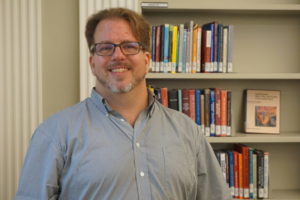
Just a year ago, we posted about the election of Brian Light, the Chief Operations Manager for the Library’s Social Science Division (AKA the guy who makes everything happen), to the Governing Council of the Berkeley Staff Assembly (BSA). The BSA “creates community, champions the interests of staff, and provides opportunities for networking and development”. It has been a great fit— Brian cares deeply both about the campus and making sure staff have a good experience here. In fact, he recently helped offer a “Staff Perspectives” event which included a presentation and discussion on the demographic makeup of Berkeley’s staff and related trends, changes, and challenges.
Well, now Brian’s work for Berkeley and with the BSA is being recognized on an even larger stage— we are thrilled to announce that he has just been elected to the University of California-wide Council of UC Staff Assemblies. CUCSA has representatives from all of the UC campuses, and works on system-wide initiatives to benefit all staff. These include making proposals to the Board of Regents and conducting biennial staff engagement surveys. In addition, “CUCSA has been instrumental in the success of several initiatives including the formation of the Staff Advisors to the Regents role, post-employment benefits, and domestic partnership benefits”. No one could deserve this honor more, and no one will work harder for the benefit of all UC staff than Brian!
Congratulations, Brian, and please keep us posted about your experiences with CUCSA!